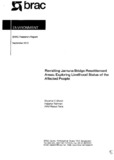| dc.contributor.author | Ghosh, Shyamal C | |
| dc.contributor.author | Rahman, Hasanur | |
| dc.contributor.author | Rana, AKM Masud | |
| dc.date.accessioned | 2019-12-04T10:46:38Z | |
| dc.date.available | 2019-12-04T10:46:38Z | |
| dc.date.issued | 2010-09 | |
| dc.identifier.citation | Ghosh, S. C., Rahman, H., & Rana, A. M. (2010, September). Revisiting Jamuna bridge resettlement areas: exploring livelihood status of the affected people. Research Reports (2010): Economic Studies, Vol - XXVII, 29–72. | en_US |
| dc.identifier.uri | http://hdl.handle.net/10361/13203 | |
| dc.description.abstract | Jamuna Multipurpose Bridge (JMB) project was the first of its kind which incorporated
resettlement activities facilitating livelihood restoration of the project affected people (PAP). This
study was an endeavor to reveal the livelihood status of the PAP after the implementation of the
project in 1998, using both quantitative and qualitative methods. Findings revealed that though
the livelihood of the PAP were affected due of loss of land or other assets and/or change of
occupation, failure to utilize the compensation money, unavailability of skill development training
they could manage to restore their livelihood during the post-project time. Regardless of the
category of PAP, the rates of literacy (59%) as well as the use of tube well water (99%), sanitary
latrine (40%), and electricity (50%) increased in both districts during the post-project time from
that of pre-project time. Additionally, the status of child immunization (86% in Tangail and 91% in
Sirajganj) and the use of contraceptive (61% in Tangail and 67% in Sirajganj) was also higher than
the national status after the bridge construction. Self-rated food security status showed the
reduced proportion of deficit households i.e. from 64% during the pre-project time to 55% during
post-project time. All these factors indicated the improvement of quality of life during the postproject
time. However, the PAP faced difficulty since agriculture was severely affected due to land
acquisition and people shifted to non-farm activities. The logistic regression indicated that the
probability of reporting good quality of life was less likely among the poor, who owned less than
50 decimals of land as well as the PAP who were in Sirajganj compared to their counterparts. The
JMB resettlement policy and activities were not always appreciated by the PAP and thus, a future
resettlement activity for any similar project needs revision to make it more effective for livelihood
restoration with minimum difficulties. | en_US |
| dc.language.iso | en | en_US |
| dc.publisher | BRAC | en_US |
| dc.subject | Jamuna Multipurpose Bridge | en_US |
| dc.subject | Livelihood | en_US |
| dc.subject | Tangail | en_US |
| dc.title | Revisiting Jamuna bridge resettlement areas: exploring livelihood status of the affected people | en_US |
| dc.type | Research report | en_US |

